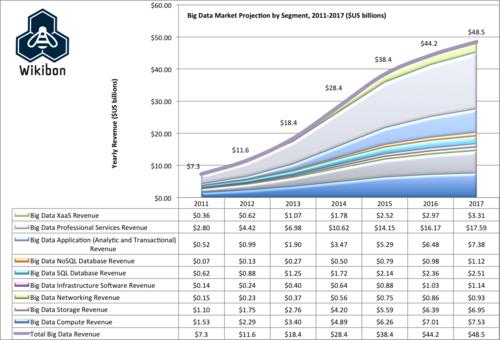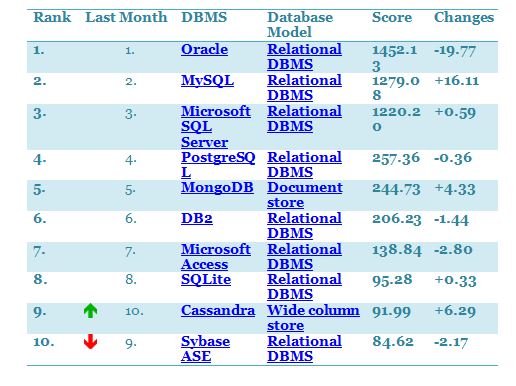Big Data Demands Effective DBMSs
The demand for database management systems that store, allow access and transfer large amounts of data in an efficient manner continues to rise. Large corporations and even small businesses are rethinking how their data management systems are structured; all the way from the basics like choosing the right client-server to more advanced concepts like considering multithreaded data management system development.
Wikibon.org published the results of a study last year that showed the total revenue of the Big Data market in 2012 at just under $12 billion. That is certainly a big number, but that is nothing compared to the projected 2017 total revenue of over $47 billion! That works out to an increase of somewhere around just over 60% per year, staggering figures. All of that leads to a much more complicated problem for businesses and data management system developers.

Source: Wikibon.org 2013
Choosing the Right System Design
There are many decisions when it comes to the architecture of a database system. Before you leap into the murky waters of considering single threaded vs. multithreaded data management system development, you need to start with choosing the client-server that is right for your project.
What is the right client-server and database model for your project?
Deciding what client-server is the right one for the job is not an easy task. It is always good to be informed and knowledgeable about these subjects yourself. However, if you are running a business, then you really need to have an expert walk you through the various options to see what is the best fit.
There are many options that factor into which server will perform the best such as how many users, how much data will be stored/processed and many other factors. Db-engines.com publishes regular rankings of the most popular database management systems. Below are the rankings for the top ten most popular DBMSs as of November of 2014, which shows the company as well as the type of database.

Source db-engines.com 2014
Like most products, each of the client-servers has their advantages and disadvantages. If you are choosing a system that is in the top ten, then you can be certain quality will not be a concern. The names on that list have been around a long time and have plenty of experience with client-server technology, DBMS programming and multithreaded data management system development.
Generally speaking, if you stick with a well-known database engine you should be fine. This can vary if you have an extremely large or specialized project, so make sure you work closely with your IT professional before deciding.
Things to Think About When Choosing a DBMS
-
Is the DBMS reliable?
-
Is it flexible?
-
Can we scale it to our needs later?
-
Do we know what we are getting?
-
Can we manage it easily?
If you noticed on the chart above, the most popular model of DBMS in the top ten is the relational model. In fact, if you were to look at the top forty that trend would also continue and the ratio would be very close to the same. Part of the reason for that is relational models have a reputation for meeting the requirements of the questions above.
There is nothing particularly wrong with the other models but the support and resources widely available for relational DBMSs make it attractive. That could change in coming years, as object oriented models are becoming more popular because they have a little more flexibility in how they store multimedia files. The IJMTER published a research paper, which gives a comprehensive comparison of relational vs. object oriented models and what the future may hold for both.
International Journal of Modern Trends in Engineering and Research International Journal of Modern Trends in Engineering and Research (IJMTER)
Volume 01, Issue 05, [November – 2014]
DBMS Models
Relational
-
Stores data as one or multiple tables with the ability to relate individual data in a highly flexible manner
-
Good for preventing duplicate data, processes complicated queries fast, good security, API supported
Hierarchy
-
Files are stored in a "tree" like structure with less flexible cross referencing ability
-
Less query flexibility, tendency to duplicate data, more strict data structure
Document Oriented
-
Main category for NoSQL and sometimes referred to as document store
-
Detailed internal architecture has the ability to read and extract many fields of data
-
Range of fields much more expansive as opposed to non-document based systems
Object Oriented
- Data stored as an object with attributes in a particular class, flexible data structure, API supported
Semi-Structured
-
XML, flexible, processing speeds may be slower, questions with efficiency
-
Uses tags, classes and attributes to identify, store and reference data
Application Development
Multithreaded Data Management System Development
Building the bridge between the database and the application programming is very important, as it will determine how well the entire system functions. The capabilities to manage large amounts of data, multiple users, command processing speed, security and efficiency will all depend on it.
Dealing with large amounts of files that are in different formats, such as pictures, videos, meteorological data and perhaps even torrents can be demanding on a system. Multithreaded data management system development can help the database to perform more efficiently.
Multithreading will allow a program or an OS to handle multiple users and requests simultaneously by utilizing multiple threads, as opposed to running the program multiple times. It uses the program resources more effectively by handling multiple queries or commands and tracking them with multiple threads until completed.
Multithreaded programs can also use multiple threads on multiple processors, where a sequential program can only use one processor at a time. Obviously, this improves overall performance and is important especially if you require your database to constantly collect, store, process and move data while also accepting commands from multiple users. Additionally, the need for multiple servers is eliminated because of the server can utilize more than one thread to carry out the work.
There can be some downsides though. Particularly, it is more difficult to write the code for the type of capability and to write it correctly. Along with that, there can be more potential for problems if the coding is not done properly.
Advantages of Multithreading
-
Increase performance
-
Concurrency
-
Reduce number of servers needed reducing cost and maintenance
-
Compatibility with applications that create client threads such as API
-
Parallel tasks
-
More efficient use of system resources
Disadvantages of Multithreading
-
Synchronizing resources that are being shared
-
Potential deadlocks
-
Increased complexity in programming as well as troubleshooting problems
New World, New Solutions
In today's world, big business and small business alike have to find better solutions to deal with the increase in data management and access to data. While some of the concepts discussed above were perhaps only for a select few, several years ago, they are becoming more applicable to smaller operations. We may not be there quite yet, but it is coming.
We have experience on all levels of multithreaded data management system development and web development in general. We would love to know what your thoughts are and if you have a technology need we can help you with. Do you think multithreading might be a viable option for your database? Let us know, we would love to hear from you and hear your questions or comments.
